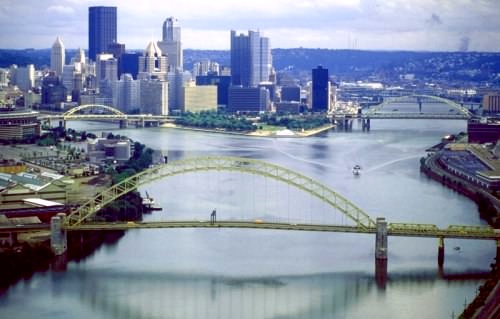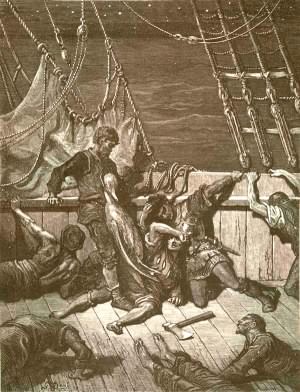The Point is Gained
June 14, 2009
After the disaster of the Lorelei, Eve had sensed that I'd lost confidence in my ability to sail. Indeed I'd said as much to her. So she encouraged a little side trip. On June 7, we trailered the Bravo up to the safe waters of Moraine State Park. There, on an afternoon with warm sun and gentle winds, we skimmed to and fro across the waters and I regained my sea legs.
Over the next week, I watched the wind and water closely. It was all coming together, it seemed to me, on Sunday. The river currents had dropped to Natrona-10,000 cubic feet per second and Elizabeth-a mere 4,000. The winds had now shifted direction. They were to blow from the WNW at a gentle 4 mph. That meant they would be blowing against the current and along the river. Winds from the North West would be ideal They would blow right along the center of the narrow stretch of the river at the marina. There would be nothing to deflect the wind to different directions every few yards. West North West seemed close enough.
All the signs were aligned. Today had to be the day. So I loaded my sailing gear into the bike and navigated out through the gay pride festival on our street to the river. When I arrived at the marina, the winds seemed meager. I'd measured speeds up to 8 or 9 mph on the ride over. But I could see only lethargic winds on the water here. What heartened me was to see that there was no visible current; debris in the water just seemed locked in one place.
I set out, pointing the boat upstream towards the point. All around me were the familiar terrors of the Lorelei, Scylla and Charybdis. Once on the river, I had a gentle breeze coming from behind me. This is one of the easiest points of sail. With the wind behind you, the sail is really just a big bag, catching the wind and dragging you with it. I began to feel an easier comfort with the boat. It was sailing directly where I needed to go. The progress was slow, but it was sure. When you sail with the wind, it is easy not to sense your motion. You are like a balloon carried by the wind; on the balloon itself, all is perfectly calm.

When I passed the impassable landmarks around the West End Bridge, as its enormous span passed over my head, I knew that this time I would gain the Point.
With each sail, you do things a little better. Last time, I found myself kneeling on the deck as the best way to be able to shift my weight in response to changes in the wind. The outcome had been that I'd rubbed my knees raw on the little bits of grit that lay there. So this time I had gardener's foam kneeling pads. No doubt I was quite a sight, but on the river, you do what you have to.

It took about 45 minutes. As I got closer to the point, the density of pleasure boats increased. This was the final day of the Three Rivers' Arts Festival and the crowds were out. It was a glorious day--pleasant sun and temperatures in the 70s F. It was only now as I was beginning to relax that I noticed just how lovely it was.
My sailboat was carried leisurely by the wind past the landmarks. After the bridge came the new casino, still under construction. Its curved glass windows were quite visible, straining forward to the water. Then came the science museum with it submarine and then finally the waters of the Point. I could keep track of the wind direction through the many flags on the boats and nearby buildings.
When I was aligned with the point, I turned my bow South. Everything changed. I was now sailing across the wind. The calm air was gone, the sail was pulled taut and the hull was slicing through the water. The Point grew larger and I selected a spot with nothing moored at it.
Docking a sailboat in the wind is a little tricky. There's no brake. The best strategy is to sail up close to the dock and then suddenly turn directly into the wind. That will stop the boat instantly. That is just what I did, right at the feet of a startled couple who were sitting next to the cleat to which I would attach my mooring line. "Now that was a good docking," I exulted smugly to them. They were too distracted to reply, trying to make sense of a sailor with a strange hat and knee pads who had suddenly sprung out of the river.
I stood on the Point, stretching. I called Eve to boast."I did it! I'm standing on the Point!" I took a few photos with my iPhone to document the event.


If I'd been courageous, I would have gone out and sailed further upstream. But I was a little worried about returning to the marina. The sail from the marina had been easy. I just let the wind blow me along. The return would require me to tack back and forth into the wind and there wasn't much current to aid me. Might I get trapped in another episode of "Groundhog Day," endless tacking back and forth but gaining no distance?
I settled down on the deck, untied the mooring line and pushed the bow into the river. The flags over the arena showed a wind blowing from the North, but the direction on the river was less certain. So I started tacking back and forth, getting a sense of how the wind blew. A large river boat approached. I knew I wanted to stay well away from it, so I found a quiet spot near the shore and furled the sail, while I watched it steam past. Then I started the long tack home.
When you tack into the wind, you have much less freedom in the direction you sail. The sail now acts like a wing, lifting you into the wind, and not like a bag, carried ahead of the wind. You point the bow as close to the wind as you can get it. You know you've come too close when the sail loses lift and starts to flap, or "luff," as it is called.

Once you are close hauled to the wind, there is only one direction you can turn, away from the wind. If there is an obstacle there, you are in trouble if the wind shifts even slightly. You've nowhere to go.
I tack back and forth, gradually making my way downstream, picking a course between the boats on the water. Their occupants watch quizzically, as I cut to and fro, sometimes coming close to their sterns or bows. They have no idea of the little geometric problems I am solving as I chart my course. They think I am just meandering about.
It is pretty clear that powerboat sailors generally do not understand sailboats. Fortunately, most know the rules of river, which are that powerboats must always give way to sailboats. "Sail before steam" is the century old slogan. Most powerboat sailors are kind to me. They steer well clear and slow down so that they do not swamp me with their wakes.
Every now and again, a jerk piloting a great fake phallus speeds by. He leaves a wake that, from my perspective, low in the water, looks like tidal wave. I need to steer my bow directly into the monster so that I am not swamped. That can be tough if the winds are difficult. Even then, the waves will break and wash across my deck.

I am now approaching the West End Bridge. It becomes much clearer to me why I had so much trouble sailing there. Everything changes as I near it. The wind still blows, but it now has a gravely, unhelpful texture to it. I tack back and forth, but no longer seem to make much headway. This stretch of river, I realized, truly is cursed.

Tacking is a tricky maneuver. You sail in one direction, then steer the bow directly into the wind and hope to come out the other side of the wind. If things go poorly, the bow will stall pointing dead into the wind. You are "in irons."
In these accursed waters, I was trapped in irons time and again. I needed to use all the tricks I had learned with this boat just to keep going. Sometimes, when you are in irons, you let the wind blow you straight back. If you reverse the direction of the rudder, that backwards motion can turn the boat to let you complete the tack. The movement is rather like reversing a car. Or, using a little trick I cooked up at that moment, you can reef the sail down to one third its size and go round the other way, "jibing" harmlessly with the small sail.

Tack by tack, I picked my way back to the marina. Ulysses sailed past the monsters of Scylla and Charybdis. I sailed past the looming hulls of big power boats, whose pilots, on this stretch, seemed remarkably indifferent to a little sailboat swinging wildly in their wakes. An hour after I left the Point, I docked at the marina. This time, I was Ulysses, triumphant, home from his voyages.
John D. Norton
Back to main